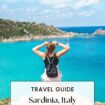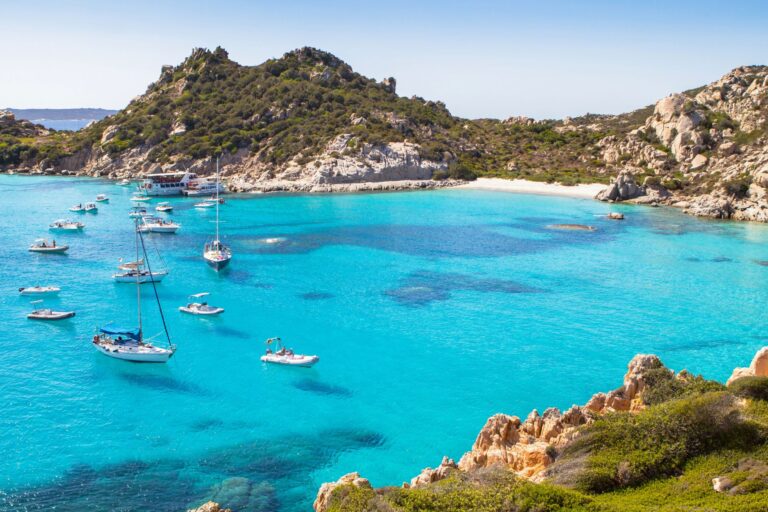
We are reader-supported and may earn a commission on purchases made through links in this article.
Sardinia’s metamorphosis happened over just a few short decades.
When I first visited Sardinia years ago, my Italian brother-in-law made a point of instructing me in Omerta, the Sardinian ‘Law of Silence’: “I wasn’t there. Even if I was, I didn’t see anything. Even if I saw it, I didn’t understand what I saw. But even if I understood, I don’t remember anything.”
Mainland Italians long saw insular, clannish Sardinia ‒ where banditry was common, women wore black and many even covered their faces with veils ‒ as mysterious and unfamiliar, the least Italian of the country’s regions.
Sardinia: From Pristine Beaches to Breathtaking Panoramas
But times have changed. Today, millions of tourists, particularly in summertime, invade the island every year. Its beach resorts ‒ particularly the famous Costa Smeralda, where the metamorphosis began ‒ are among the most extolled, and upscale, in the Mediterranean.
Best Tips & Tools to Plan Your Trip
And, yes, the beaches are undeniably exquisite: powdery white sands with crystal-clear waters of bold aquamarine and sea green.
Not everyone, however, comes to Sardinia only for sea and sand. It’s also among the most beautiful islands in the Mediterranean, if not the most picturesque of all. On a 10-day driving trip, looping the entire island, every turn brought ravishing panoramas and vivid natural settings ‒ from towering cliffs and spectacular coastlines to a nearly 500-foot-tall sea stack (a column of rock rising from the sea).
Sunny, Historic Cagliari
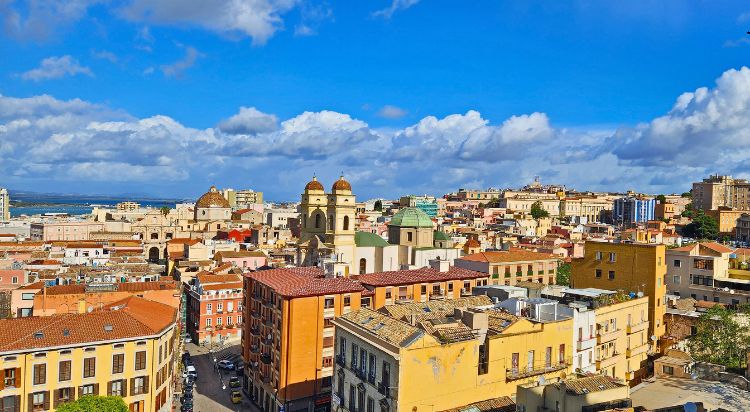
Sunny Cagliari, the capital. with its cheerful architectural palette of earthy yellows, oranges and browns, is an easily walkable and inviting introduction to Sardinia.
The historic heart of the city, the Castello district, is a high promontory enclosed in stone bastions protecting cobbled medieval lanes and towers, churches, squares and museums, even a Roman amphitheater. The sprawling terrace of the Bastione Saint Remy commands a boundless vista of city, gulf and faraway mountains.
Below Castello, along the seafront, the Marina district is a maze of stone lanes and alleys dotted with shops, boutique and eateries. Marina explodes to life in the evening when a multitiude of tourists and locals alike arrive to shop and dine at both innovative, modern spots like gourmet pizzeria Sa Sascharonada and celebrated institutions like Antica Cagliari restaurant.
Summer Playground of San Pietro
A short ferry ride brought us to the vacation island of San Pietro and easygoing Calaforte. Warm, radiant colors of field flowers paint the town’s four-story houses with wrought-iron balconies that line the grid of streets leading to quaint squares, ancient churches, hotels and restaurants. Surrounded by beautiful beaches, Calaforte and San Pietro are a lively sea and sand playground in summer.
At the northern tip of San Pietro, La Punta (The Point) is a wild, rocky shoreline of tide pools with a jagged coral shelf slammed by continuous waves. The raw, untamed nature shields the forgotten recent past: the abandoned tuna cannery here that once was the island’s sustaining livelihood. The days of the great tuna catches are gone, the cannery now a silent memory.
Sardinia’s Indescribably Beautiful Coast
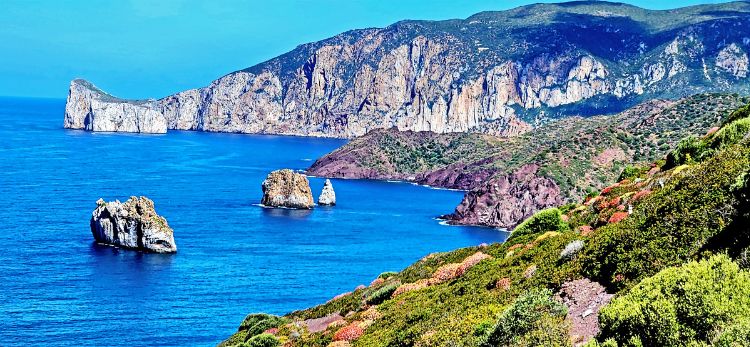
Aboard the ferry back to the main island, in the distance was a fierce, massive wall of granite, streaked in white and gray, standing guard over the Costa Iglesiente.
The roads along the shores here segued from the indescribably beautiful to the transcendental: craggy promontories with verdant fingers of land reaching into the water, arc-shaped coves with golden sands, soaring cliffs, lush green countryside where farmers sell their cheeses and wines to passersby, and islets floating in a profound blue sea dotted with swirls and splashes of translucent greens.
The star of the show is massive Pan di Zucchero, a 436-feet-tall sea stack named after Rio’s Sugarloaf that is among the most imposing natural monuments of the island.
Bouncing down a dirt and gravel track down a narrow canyon, past the collapsed buildings and rusted machinery of one the many now-defunct mines on the island, brought us to Spiaggia di Piscinas: ‘Sardinia’s desert’ is a seemingly endless span ‒ running for several miles ‒ of sand dunes laced with fragrant Mediterranean scrub brush.
Fascinating Roman Ruins of Tharros
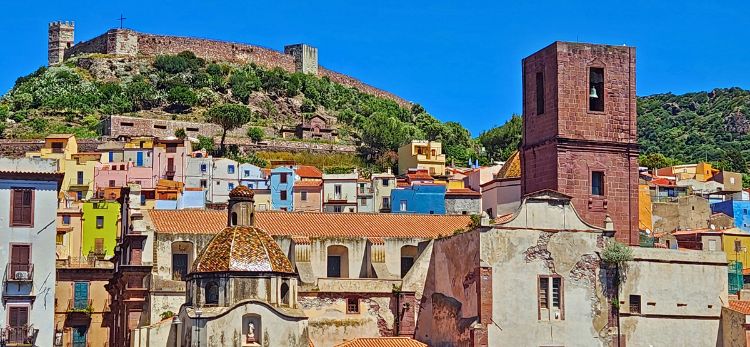
A rocky strip of land extends the Sinis Peninsula out into the Mediterranean forming a small bay that harbors an ancient archeological site, the important Roman city of Tharros that began as a Phoenician settlement in the 8th century BC. The sprawling sea-lapped ruins engross and fascinate with the dramatic remains of temples, thermal baths, aqueducts and black-basalt streets.
An iconic symbol of Sardinia, a town that has been called Sardinia’s most beautiful, is vividly photogenic Bosa. From afar, Bosa is a vision that captures the imagination: a meandering river, an ancient stone bridge entrance, medieval walls encircling houses in a rainbow of colors that are stacked up the steep slope to the edge of the grand hilltop castle.
Spectacular Marine Cave
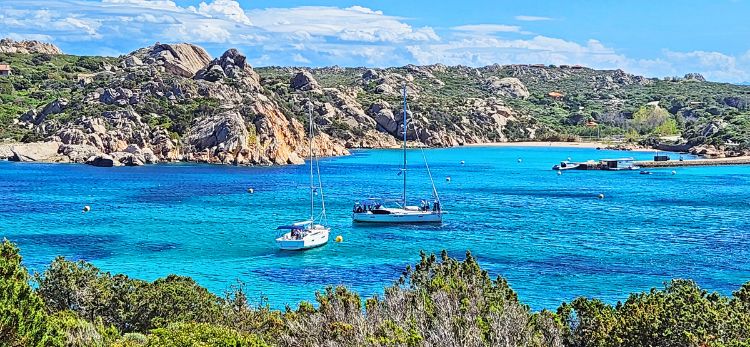
On windswept Capo Caccia (Hunter’s Cape), a tall lighthouse stood sentry at the far point, speedy swifts, swooping herring gulls and gliding peregrine falcons rode the air currents and, below white granite cliffs, was one of Italy’s largest and most spectacular marine caves.
Visiting Grotto di Nettuno (Neptune’s Grotto) was a vertiginous workout: 654 steep steps down and 654 back up (unless you take the tour boat from the nearby city of Alghero that unloads right at the sea-level entrance).
Countless stalagmites plunge from the ceiling in a fantastic array of yellows, oranges and greens, turning the partially submerged caverns into galleries of natural phantasmagoric sculptures.
Multiple ferries sail every hour between Palau and La Maddalena, testifying to the popularity of this touristy island of boutique hotels on secluded beaches. Its long, main walking street, set just one block in from the bustling port, is a lifeline of Sardinia.
La Maddalena’s Emblematic Walking Street

Hordes stream down the cobbled byway shopping for souvenirs and tchotchkes and enjoying Sardinian specialties such as porcheddu sandwiches of suckling pig cooked on the rotisserie, grilled meats, and a variety of unique-to-Sardinia pastas such as potato-and-mint-stuffed culurgiones and gnocchi-like malloreddus served with a tomato and sausage sauce.
Vacationers fill outdoor cafes, sipping Aperol Spritzes or sampling curated cocktails in sophisticated bars like The Duke (where the sign-out front proclaims tongue-in-cheek: “If you are drinking to forget, pay in advance”).
Castelsardo

Castelsardo illustrates the history of the island. In the past, the inhabitants largely lived in the interior to escape the perils of the coast: malaria, raids by pirates and assaults by the region’s many maritime powers.
This gradually changed with foreign occupation ‒ mainlanders from Liguria, Genoa and Piedmont, Spaniards from Catalan ‒ who built castles and bastions on high, defensible seaside promontories and headlands. Crowned by a massive castle built in the 1200s by Genoese, while below are much-more-recent houses lining a switchback main road to the top, Castelsardo is a captivating sight, and particularly fetching at night.
Difficult Hike But Delicious Payoff

It had been a disappointing morning: all boats to the Golfo de Orosei – widely billed as Sardinia’s most beautiful coastline, which is high praise on such a nature-blessed island ‒ were cancelled that day because of rough seas.
Moreover, the jewels of these shores, including the Bue Marino grotto and Cala Luna beach, are only accessible from the sea. With one exception: Cala Goloritze beach.
The twisting mountain road was shrouded in fog as we ascended to the Altoplano del Golgo, a high plateau of pine forests, rock villages, grazing goats and donkeys and a backdrop of high peaks.
The road became a dirt track as we negotiated a series of sharp switchbacks down to the trailhead. The hike on a difficult, steep and rock-strewn path (formerly a mule trail) took more than three hours roundtrip. But the payoff was delicious.
Emerging from a limestone canyon and on-and-off canopy of juniper and oak, we arrived at an overlook of Cala Goloritze and an unforgettable vision, a sparkling and brilliant panache of color and formations: the unbelievable intensity of the turquoise water, the fine golden sand, the massive boulders anchored on the shore, the brown-and-orangey palisades and, in the distance, high black-and-white cliffs lining the shore.
One of the World’s ‘Blue Zones’
Sardinia is one of the world’s ‘Blue Zones’ where people tend to live well into their 90s and an unusually large number to 100 and beyond. Diet, the purity of the food and low stress are among the possible reasons.
The Sard diet encompasses a wide array of locally grown produce, the island’s highly regarded hard, soft and fresh cheeses, fatty sausages, grilled meats including horse, sheep and donkey, the gamut of seafood from the Mediterranean, indigenous pasta dishes and the signature local wines.
Dry, lively Vermentino and crisp, food-friendly Vernaccia are the popular white wines, while the ubiquitous red, intense, and savory Cannonau is actually considered an elixir of long life. Cannonau is said to contain more antioxidant-rich compounds than other reds – which is why it’s believed to contribute to the exceptional longevity on the island.
Alas, there is no evidence that a brief visit to the Blue Zone will extend your life expectancy, though experiencing the joys of Sardinia and uncorking some Cannonau probably can’t hurt.
Read More:
- Travel Restrictions, a Warm Welcome and Eye-Opening Experiences in Today’s Libya - June 3, 2025
- Tajikistan and Kyrgyzstan Beckon with Ancient Legends, Modern Cities and Indomitable Mountains - January 10, 2025
- Winging It on Mellow, Undeveloped Tobago - October 5, 2024

